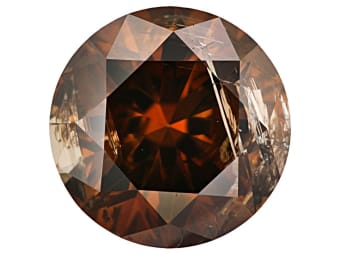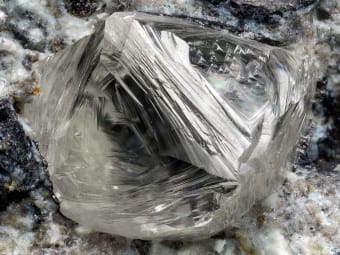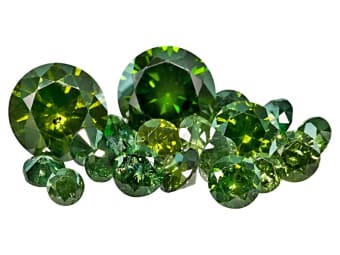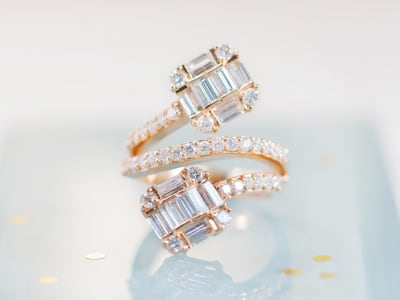Most people have heard about the four Cs of diamonds through advertisements or direct contact with jewelry salespeople. However, while familiar with the concept, most individuals are a little sketchy on the details. The four Cs include diamond carat weight, clarity, color and cut.
Diamond Carat Weight
Carat weight is pretty black and white. Diamonds are weighed in carats, which are composed of 100 points. Basically, a half-carat stone is 0.50 carats or 50 points. Carat is abbreviated as "ct." Special diamond scales calibrated to one thousandth of a carat are generally used in the jewelry trade, so diamonds are weighed to the thousandth and rounded to the hundredth of a carat. Occasionally you may hear the term "four grainer" referring to a 1-carat stone. Each grain is equal to 0.25 carat or 25 points. If you think in terms of grams, 1 gram is equal to 5 carats. This metric equivalency provides a level of uniformity anywhere in the world.
Due to the limited supply of larger diamonds, the value of a diamond rises disproportionally as the weight of the stone increases. For example, four 0.25-carat diamonds of the equivalent quality will not equal the value of a single 1-carat stone of identical quality. The disparity becomes more noticeable as the size and quality of the diamond increases.

Diamond Buying Tip: Note that "carat" describes the weight of a stone, not the size. Carat weight and size are fairly uniform from diamond to diamond so a 1-carat round diamond will consistently measure around 6.5 mm. (Colored stones, however, are a different story. Since density varies from one gemstone to the next, shape and dimensions must be specified. If you are ordering a colored stone for your favorite 1-carat round diamond semi-mount, then you also need to specify 6.5 mm for the size. Standardized calibrations were created for gemstone and jewelry manufacturing.)
Diamond Clarity
Clarity is determined by the type, size, number, position and contrast of inclusions. Contrast is important, because dark inclusions in a diamond are more visible and therefore more distracting from a diamond's beauty than white or gray inclusions. Plus, if an inclusion is positioned in just the wrong spot, it can be reflected within the stone multiple times, making the diamond appear even less attractive and negatively affecting its clarity even more. Inclusions occur within the stone, while blemishes are external in nature. There are many grading scales used to describe diamond clarity; however, the diamond grading scale used by the Gemological Institute of America (GIA) is probably the most well known. The scale can be broken down as follows:
Flawless (no inclusions under 10x loupe)
IF (internally flawless, surface blemishes
exist)
VVS 1, 2 (very, very slightly included:
minute inclusions)
VS 1, 2 (very slightly
included: minor inclusions)
SI 1, 2 (slightly
included: noticeable inclusions)
I 1, 2, 3
(included: observable inclusions)
Diamond grading should always be performed with a 10-power (10x) loupe or microscope under proper lighting by a trained gemologist. Inclusions in stones graded I1, I2, and I3 can be seen by the unaided eye.
Note: In some cases the term "imperfect" will be substituted for "included" when describing VVS, VS and SI stones. Diamonds in the I range are also sometimes referred to as imperfect 1, 2 or 3.

Diamond Buying Tip: Clarity makes a significant impact on the price of the stone, but when shopping for diamonds, you should remember that clarity does not always significantly affect a diamond's brilliance and better clarity does not always ensure a more brilliant stone. While clarity does affect a diamond's brilliance, the stone's cutting largely determines its brilliance. In fact, most people cannot discern the visible difference between diamond clarity grades “flawless” through “slightly included.”
Diamond Color
Color grades, using the GIA scale, ranges from D to Z, with D being colorless and Z being heavily (usually yellow) colored. Colorless stones (designated D, E or F) command the highest prices. Diamond colors rank in the following groups:
Colorless: D, E or F
Near
Colorless: G, H, I or J
Faint Yellow
Tint*: K, L or M
Very Light Yellow
Tint*: N, O, P, Q or R
Tinted Light
Yellow*: S, T, U, V, W, X, Y or Z
* The tint viewed may actually be yellowish, brownish or gray.
When grading diamonds, a nonreflective white background should be used. Diamond graders have to be careful about the surrounding environment. Clothing color, lighting and the color of their instruments may affect the outcome.
Fancy Colored Diamonds
Diamonds of certain colors are called fancies. These colored diamonds have intense natural colors that in some cases are very rare and command exceptional values. These stones are not color graded using the scale above. Brown and yellow diamonds are the most common members of the fancy diamond group and have a distinct beauty of their own. Naturally red, blue, purple and green diamonds are extremely rare and highly sought after by designers and collectors.

Diamond Buying Tip: Color is one of the most noticeable characteristics of a diamond. Most people can notice whether or not a diamond is colorless (the most desired). The setting of the diamond can affect the appearance of color. If the diamond is colorless, a white gold or platinum setting will enhance the diamond's whiteness. But if the diamond has a yellowish tint, a yellow gold setting may help mask the yellow tint, making the diamond appear whiter.
Diamond Cut
The breathtaking beauty of a diamond comes from a combination of fire (that flash of rainbow colors that comes from within) and brilliance (the burst of sparkling light). This dazzling beauty is a direct result of the diamond's cut. The last of the four Cs, cut is a little more complicated than just the shape or visible outline of the diamond. Cut also refers to a diamond's faceting as well as the diamond's symmetry, proportion and finish (known in the trade as the "make").
There are three basic styles of diamond faceting: brilliant cut, step cut and mixed cut.
Brilliant: Designed for maximum diamond sparkle, the
brilliant cut uses many triangular and kite-shaped facets.
Step: Instead of sparkle, a step cut aims to increase
a diamond's elegance with fewer facets and more trapezoids and
rectangles.
Mixed: A mixed cut combines the
step and brilliant cut styles for a uniquely beautiful diamond.
All diamonds are cut to certain tolerances designed to maximize the play of light within the stone. If the stone varies too greatly from the accepted standards, light is lost through bottom or sides, reducing the diamond's liveliness and overall beauty. As a general note, most full-cut round brilliant diamonds have either 57 or 58 facets, depending on the absence or presence of a culet (the bottom-most facet or "point" of a stone).


